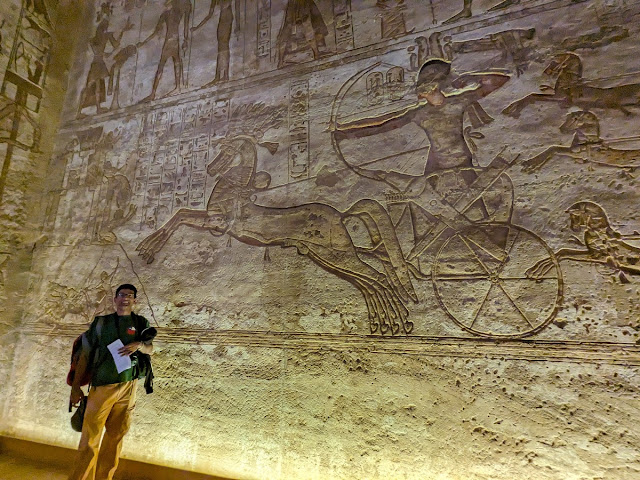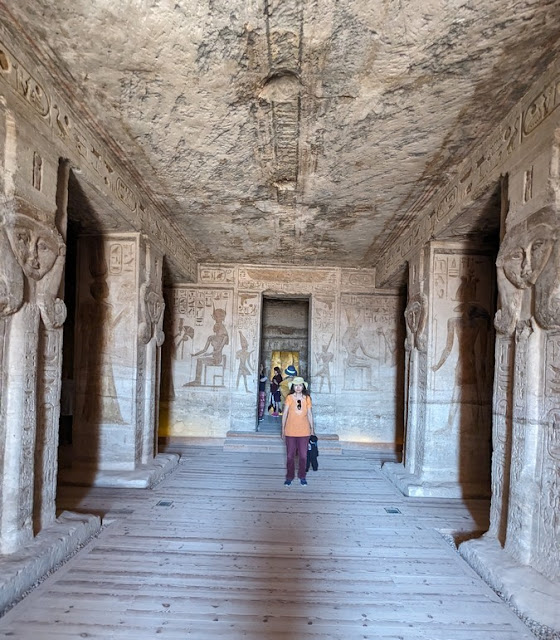Checkout, 6am owner's boat ride to ferry dock Koti side, Aswan to Abu Simbel, Checkin to apt, Abu temples. Evening 5 pm back to temples, 20usd tickets for Sound, light show, 6.30 show under a sky lit up with 100 plus stars
We confirmed the driver will be ready to pick us up at 6 am . Abdul ferried us on the owner's boat to the Aswan pier Koti side where thankfully our car was waiting [after ditching us the previous day]. Special permit is needed for this drive as with the Abydos-Dendera drive as Egyptians are particular about their military installation sites but drivers get our passport details and file for permission before the drive... part of routine for them.
two massive rock-cut temples in the village of Abu Simbel (Arabic: أبو سمبل), Aswan Governorate, near the border with Sudan. It is located on the western bank of Lake Nasser, about 230 km (140 mi) southwest of Aswan (about 300 km (190 mi) by road).
The twin temples were originally carved out of the mountainside in the 13th century BC, during the 19th Dynasty reign of the Pharaoh Ramesses II.
The complex was relocated in its entirety in 1968 to higher ground to avoid it being submerged by Lake Nasser, the Aswan Dam reservoir.
Our apartment was 1 km away, our driver dropped us at the temple at 9.15am after checkin
During his reign, Ramesses II embarked on an extensive building program throughout Egypt and Nubia, which Egypt controlled.
Nubia was very important to the Egyptians because it was a source of gold and many other precious trade goods. He, therefore, built several grand temples there in order to impress upon the Nubians Egypt's might and Egyptianize the people of Nubia.
The most prominent temples are the rock-cut temples near the modern village of Abu Simbel, at the Second Nile Cataract, the border between Lower Nubia and Upper Nubia. There are
two temples, the Great Temple, dedicated to Ramesses II himself, and the Small Temple, dedicated to his chief wife Queen Nefertari.
The Great Temple at Abu Simbel
Construction of the temple complex started in c. 1264 BC and lasted for about 20 years, until 1244 BC
RELOCATION
the reservoir that was created by the construction of the nearby Aswan High Dam threatened to submerge Abu Simbel, Between 1963 and 1968 a workforce and an international team of engineers and scientists, supported by funds from more than 50 countries, dug away the top of the cliff and completely disassembled both temples, reconstructing them on high ground more than 200 feet (60 metres) above their previous site. In all, some 16,000 blocks were moved.
The
66-foot (20-metre) seated figures of Ramses are set against the recessed face of the cliff, two on either side of the entrance to the main temple.
Carved around their feet are
small figures representing Ramses’ children, his queen, Nefertari, and his mother, Muttuy (Mut-tuy, or Queen Ti).
Ramesses II is regarded as the greatest, most celebrated, and most powerful pharaoh of the New Kingdom, which itself was the most powerful period of ancient Egypt.
He is also widely considered one of ancient Egypt's most successful warrior pharaohs, conducting no fewer than 15 military campaigns, all resulting in victories, excluding the Battle of Kadesh, generally considered a stalemate
The entrance doorway itself is surmounted by bas-relief images of the king worshipping the falcon-headed Ra Horakhty, whose statue stands in a large niche.
Ra holds the hieroglyph user and a feather in his right hand, with Maat (the goddess of truth and justice) in his left; this is a cryptogram for Ramesses II's throne name, User-Maat-Re.

The temple dedicated to the sun gods Amon-Re and Re-Horakhte, consists of three consecutive halls extending 185 feet (56 metres) into the cliff, decorated with more Osiride statues of the king and with painted scenes of his purported victory at the Battle of Kadesh.
On two days of the year (about February 22 and October 22), the first rays of the morning sun penetrate the whole length of the temple and illuminate the shrine in its innermost sanctuary.
The hypostyle hall
The hypostyle hall (sometimes also called a pronaos) is 18 m (59 ft) long and 16.7 m (55 ft) wide and is supported by
eight huge Osirid pillars depicting the deified Ramesses linked to the god Osiris, the god of fertility, agriculture, the afterlife, the dead, resurrection, life and vegetation, to indicate the everlasting nature of the pharaoh.

Sanctuary
Here, on a black wall, are rock cut sculptures of four seated figures: Ra-Horakhty, the deified king Ramesses, and the gods Amun Ra and Ptah.

Ithyphallic Osiris [with erection]
second pillared hall has four pillars decorated with beautiful scenes of offerings to the gods.
Battle of Kadesh

Just to the north of the main temple is a smaller one, dedicated to Nefertari for the worship of the goddess Hathor and adorned with 35-foot (10.5-metre) statues of the king and queen.
Small Temple of Hathor and Nefertari
The temple of Hathor and Nefertari, also known as the Small Temple, was built about 100 m (330 ft) northeast of the temple of Ramesses II and was dedicated to the goddess Hathor and Ramesses II's chief consort, Nefertari.
This was in fact the second time in ancient Egyptian history that a temple was dedicated to a queen. The first time, Akhenaten dedicated a temple to his great royal wife, Nefertiti.
The rock-cut facade is decorated with two groups of colossi that are separated by the large gateway. The statues, slightly more than 10 m (33 ft) high, are of the king and his queen. On either side of the portal are two statues of the king, wearing the white crown of Upper Egypt (south colossus) and the double crown (north colossus); these are flanked by statues of the queen.
Remarkably, this is one of very few instances in Egyptian art where the statues of the king and his consort have equal size. Traditionally, the statues of the queens stood next to those of the pharaoh, but were never taller than his knees.
Ramesses went to Abu Simbel with his wife in the 24th year of his reign.
As the Great Temple of the king, there are small statues of princes and princesses next to their parents.
The plan of the Small Temple is a simplified version of that of the Great Temple.
The hypostyle hall
the hypostyle hall in the smaller temple is supported by six pillars; in this case, however, they are not Osiris pillars depicting the king, The capitals of the pillars bear the face of the goddess Hathor; this type of column is known as Hathoric
they are decorated with scenes with the queen playing the sistrum (an instrument sacred to the goddess Hathor), together with the gods Horus, Khnum, Khonsu, and Thoth, and the goddesses Hathor, Isis, Maat, Mut of Asher, Satis and Taweret; in one scene Ramesses is presenting flowers or burning incense. .
The bas-reliefs in the pillared hall illustrate the deification of the king, the destruction of his enemies in the north and south (in these scenes the king is accompanied by his wife), and the queen making offerings to the goddesses Hathor and Mut.
BACK AT APARTMENT
By 1 PM, we were done enjoying the temples, we texted our driver to pick us up and got back to our apartment.
Had some hot chocolate
Son walked to the nearby market and bought some veggies
After lunch and rest at the apartment we called our driver and got dropped at the temples again in the evening by 6.30. Bought tickets 20 usd each and saw the sound and light show at 7pm
Sound & Light Show at 7 pm
we knew the story of this king in detail, so the show's content was familiar.
Highlight for us was the hundreds of stars in the sky
our driver dropped us at the apt, we had food and called it a day
Report continues here




















































































































No comments:
Post a Comment